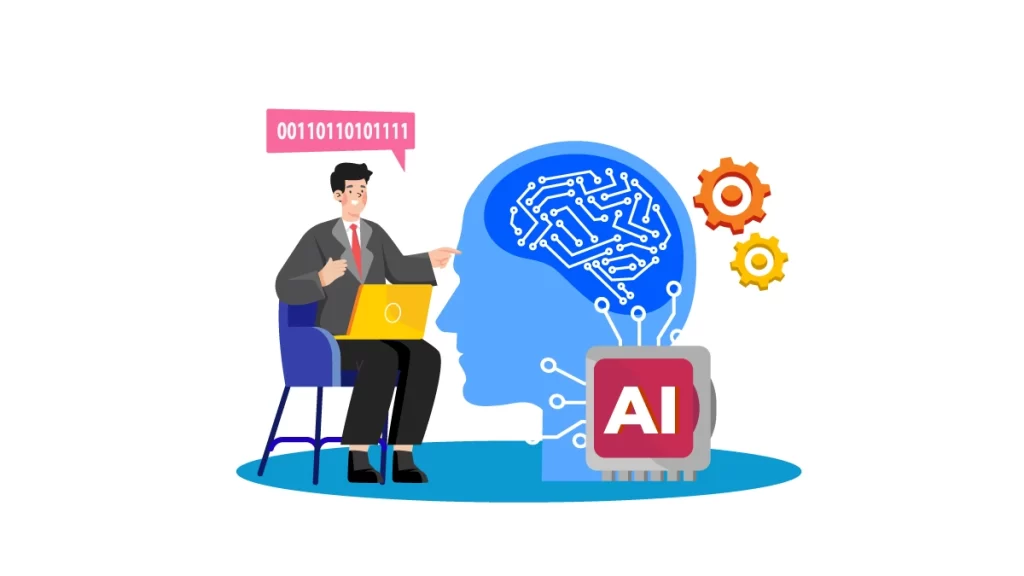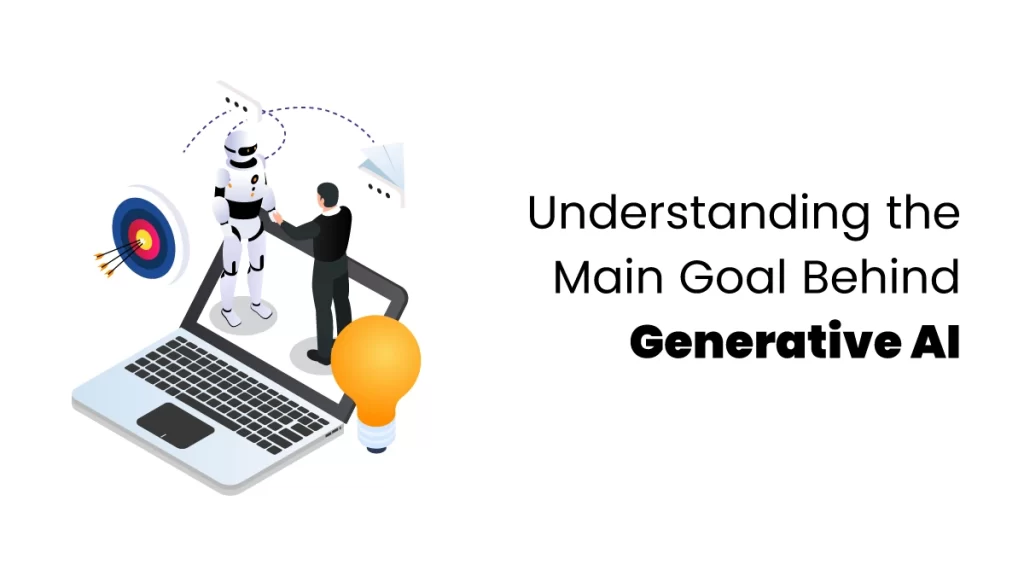In this new world of technology, Artificial intelligence is evolving day by day. The growth and revolution of AI have made many tasks simpler. If you are wondering about what is the main goal of generative artificial intelligence, then you will get an opportunity to understand it after reading this blog. You will be able to understand what is generative AI, how it works, the challenges of generative AI, and more. You can utilise this information to advance in your career and gain expertise in specific fields.
Understanding Generative AI
First, you need to understand generative AI, and then we can move on to its goals. Generative Artificial Intelligence is the type of artificial intelligence that creates new content, such as text, video, or even code, based on the data it was trained on. Some tools like OpenAI’s ChatGPT and DALL-E are increasing the enthusiasm of various tech lovers. AI aims to create valuable content that reduces human effort and generates faster outputs.
The Main Goal Of Generative AI
After understanding what is generative AI, let’s check the primary goal of generative AI. The goal of generative AI is to craft relevant human-like content from certain instructions given by the user. These instructions are termed as prompts. Giving correct prompts will provide you with the required data. This will increase human productivity in a positive direction. In other words, Generative AI helps to find new, fresh ideas, save time on repetitive content, automate content production, write code in any programming language, and solve complex problems immediately. If you are writing a blog post, a reel script, or designing software, generative AI can give you valuable suggestions to bring your ideas to life.
How To Achieve The Main Goal Of Generative AI?
The goal of generative AI is achieved by generating simple information from large language models and generative adversarial networks. The models are actually taking a small section of data and adding brand-new content based on the patterns they learned from it. Just check how a prompt works.
When a user enters a prompt, these language models search for related information and combine brand-new content after careful comparison with related data patterns. This satisfies the goal of generative AI to craft content that would be difficult for other persons to produce. That is why, when we ask AI to complete a complex piece of code, it can do so. To know more about generative AI, it is recommended to join a digital marketing training course for practical industry insights.
Types Of Generative AI Models
There are several generative models available in the market. They are described below:
- Generative Pre-trained Transformers (GPTs): These models use Natural Language Processing to understand and generate human-like content. These types of models form the basis for many text-based applications, such as ChatGPT.
- Generative Adversarial Networks (GANs): This is a deep learning model that consists of 2 neural networks, the generator and the discriminator. The generator is supposed to generate new data, while the discriminator checks whether the data is realistic. These networks compete with each other to provide far better output.
- Variational Autoencoders (VAEs): VAEs are deep learning models used for generating new data in the form of variations of input data they are trained on. In addition to this, these models consist of an encoder and a decoder. The encoder isolates important latent variables from the training data, while the decoder uses these training variables to reconstruct the input data.
- Diffusion Models: These models will refine the noise in the data set step by step to create a high-quality picture or other data set. This is how pictures are developed in Midjourney and DALL-E 2.
- Multimodal models: These models can process multiple data sets, such as pictures and text, together and produce a suitable output, which may be text, an image, or both. Example: Google’s Gemini.

How Generative AI Works?
Generative AI uses certain patterns in its training data set in order to create new content such as text, video, audio, images, etc. Let’s check how it works:
- The first step is to collect large amounts of data, including images, texts, etc. Then this data is processed and organised so the model can learn meaningful patterns during training.
- Once the first step is completed, we can use advanced machine learning techniques to train these AI Models. So that AI can understand your prompt by comparing it with similar patterns it has already learned from the dataset.
- So these AI Models will have the power to recognise a pattern. If it is a language model, it will know how to form sentences easily.
- Actually, AI uses transformer-based language models like GPT, which is trained on billions of words. These models will know how to predict the next word in a sentence and implement proper grammar.
- In the case of Image and Audio, we use GANs(Generative Adversarial Networks ) and Diffusion Models. GANs use two networks to create a realistic image, whereas diffusion models focus on random noise and refine it into a coherent image.
- AI will generate outputs that are similar to the pattern of data they have trained on.
- AI can also improve its outputs according to new user inputs.
Objectives of Generative AI
The key objectives of Generative AI are
- Unique Content Creation: Generative AI can produce human-like content. It is really designed to generate text, images, and videos that mimic human creativity.
- Boosting Human Creativity: Generative AI will enable humans to enhance their creativity and tackle complex tasks.
- Automation of Content Generation: The Generative AI can automate processes that require manual effort.
- Personalization and Adaptability: Generative AI can produce personalized outputs based on user queries. AI is adaptable to any questions the user may ask.
- Create Innovative and Creative Solutions: Generative AI enables users to generate ideas that humans could never have thought of. Sometimes it may be impossible earlier, but such things can be done now with the help of generative AI.
Some Generative AI Examples
There are many tasks that generative AI can do. A few are listed below:
- Complete the programming code with ease.
- Detect and fix bugs in code.
- Summarize patient notes.
- Create music and other sound effects.
- Create high-quality images.
- Create learning materials for students.
- Write articles, ad copies, and many other texts.
Benefits Of Generative AI
Specific benefits of the generative AI are listed below:
- High Efficiency & Productivity: Generative AI can perform complex tasks that require more human effort more easily.
- Abundant Creativity: Generative AI demonstrates strong creativity due to the extensive data it has been trained on.
- Personalized Experience: Generative AI provides a personalized experience for each individual and also analyzes an individual’s preferences and interaction history.
- Faster Research capabilities: Researchers can use Generative AI to run massive experiments via computer simulation, thereby reducing the cost of physical experiments.
- Better Decision Making: Generative AI can analyse large amounts of data from different sources, summarise information, identify hidden patterns, and perform scenario modelling to forecast potential outcomes. This will help businesses make informed decisions, with an understanding of their risks and future consequences.
Challenges of Generative AI
There are several challenges for Generative AI. They are listed below:
- Whatever generative AI creates, they will never understand what they are producing. They are just providing text that matches the patterns they are trained on.
- AI Models can inherit biases from their training data, thereby leading to unfair outputs.
- Sometimes AI can be misused to create copyrighted content.
- Training AI Models requires a high computational cost; sometimes, smaller companies cannot afford it.
- To ensure quality in content generated by generative AI, human oversight is essential.
- Sometimes, even AI produces false but reasonable results for our query. It is the responsibility of humans to cross-check the details provided by AI to determine whether they are true.
- AI also raises data privacy concerns, as it can collect and store data.
Conclusion
In Summary, you have understood what is generative AI, its main goals, its functions, its benefits, and its challenges. Now you’ve got an answer to how AI models generate text or images when we ask them to. Generative AI can support innovation and thereby increase productivity. For this reason, millions of people use generative AI to perform complex tasks that would otherwise take a long time. Generative AI also enables faster research possibilities. Even though there are many challenges, such as accuracy and privacy issues, Generative AI can have a greater impact by driving development across industries. If you want to explore more about generative AI, you can consider enrolling in a digital marketing course in kochi.
FAQs
1. What is the main goal of Generative AI?
The main goal of Generative AI is to create new content —such as text, images, music, or videos — that look and sound like they were made by humans.
2. How does Generative AI achieve its goal?
It learns from large amounts of data and uses that knowledge to produce new, original outputs.
3. Can Generative AI replace human creativity?
No, it doesn’t replace creativity but supports it by giving new ideas and helping people work faster.
4. What are some examples of Generative AI tools?
Examples include ChatGPT for text, DALL·E for images, and music-generating AI like Jukebox.
5. Why is Generative AI important?
It saves time, increases creativity, and makes it easier to produce high-quality digital content.










